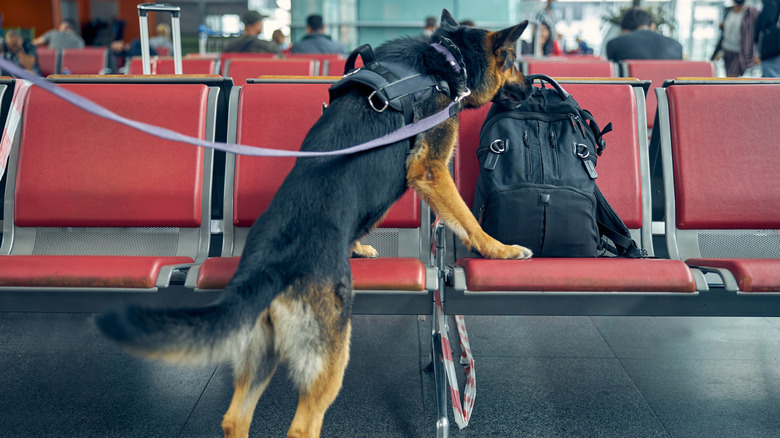Here's How A Dog Is Able To Detect A Bomb
If you're an animal lover, you probably remember some of the dogs you've seen at airports over the years. It may have been the adorable Yorkie in front of you in the baggage screening area or the friendly Frenchie that barked hello when you were at your gate. Perhaps it was the dog with the police officer that sniffed you and your carry-on as you walked by, searching for evidence of a bomb. Dogs can detect an explosive device with their noses by being trained to find and respond to specific chemical odors found in bombs.
Dogs have more than 100 million olfactory receptor sites, allowing them to smell up to 10,000 times better than a human. Their long noses also allow them to inhale more air when they sniff something. This means dogs can detect scents that humans can't, including bombs and bomb residue. German shepherds, bloodhounds, Labrador retrievers, and American pitbull terriers are among the breeds that have been successful in bomb detection. They're also among the top dog breeds by sense of smell.
Bomb-sniffing dogs, also known as bomb dogs and explosive detection dogs (EDDs), are used at airports, in the military, in stadiums, and other places where large numbers of people congregate. However, it takes months of training for them to learn how to detect a bomb and to respond in a specific way to the scent.
Steps to bomb-sniffing dog training
Before a dog can be trained to detect a bomb, it has to first be trained to take an interest in the smell. For example, if a dog is being trained as a military bomb-sniffing dog, the trainer holds an explosive device in front of the dog's nose as the first step of training. The trainer then waits until the dog sniffs the device before giving it praise in the form of words, a treat, or both to reward the behavior. After repeating this positive reinforcement training, the dog will associate the sniffing behavior with a reward.
The next step in training involves learning how to seek out the EDD scent. Since bombs are usually hidden, bomb dogs must learn how to use their noses to find them. For this step, the trainer hides the EDD, encourages the dog to sniff it out, and rewards it again when it finds the device. Dogs can be trained to detect various chemical odors in bombs, including ammonium nitrate, TNT, and nitroglycerin (found in dynamite) since not all explosives use the same combination of chemicals.
Next Pittsburgh and the Allegheny County Police Department's K-9 unit show how the final steps come together. Using the same food and reward praise conditioning, trainers typically train bomb dogs to sit and make eye contact with the person holding the leash after they've detected a specific EDD smell. The dog is then rewarded for finding the bomb, both in training and in real bomb-sniffing scenarios.

